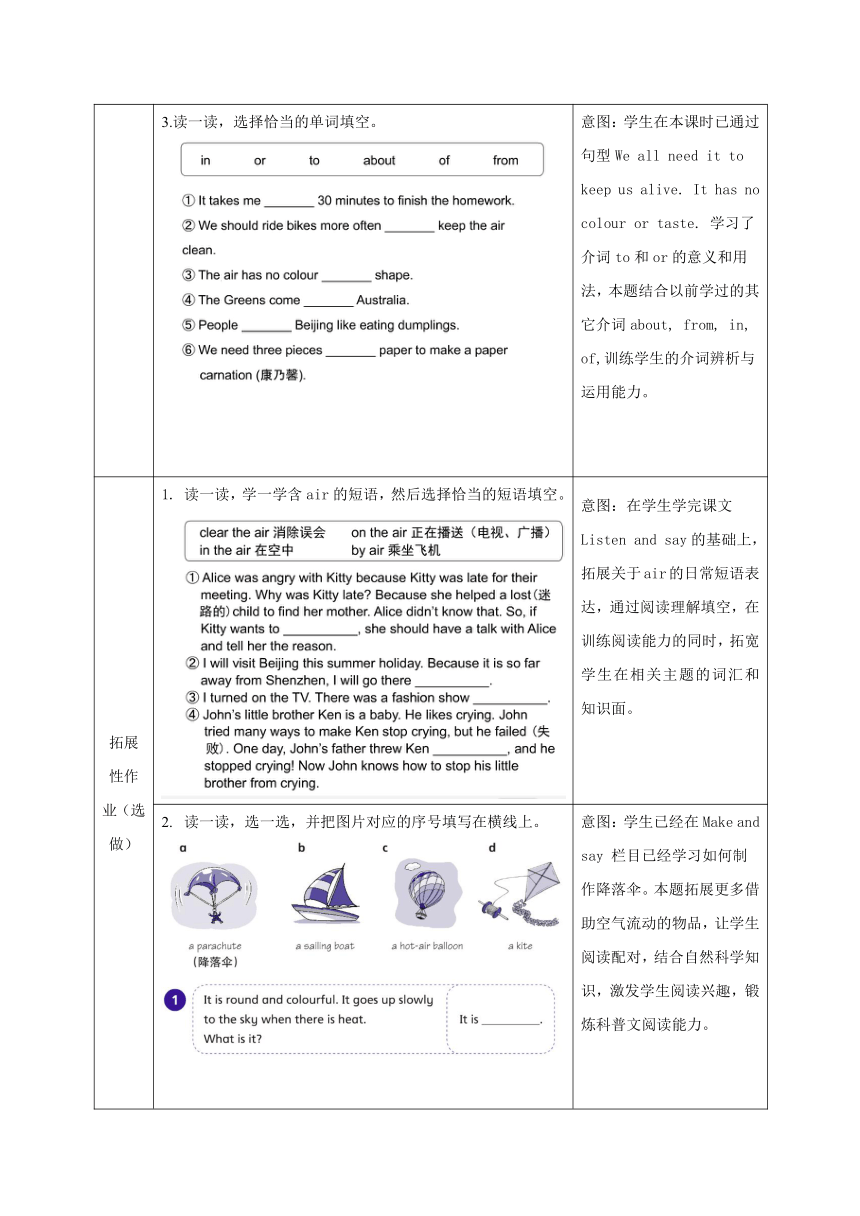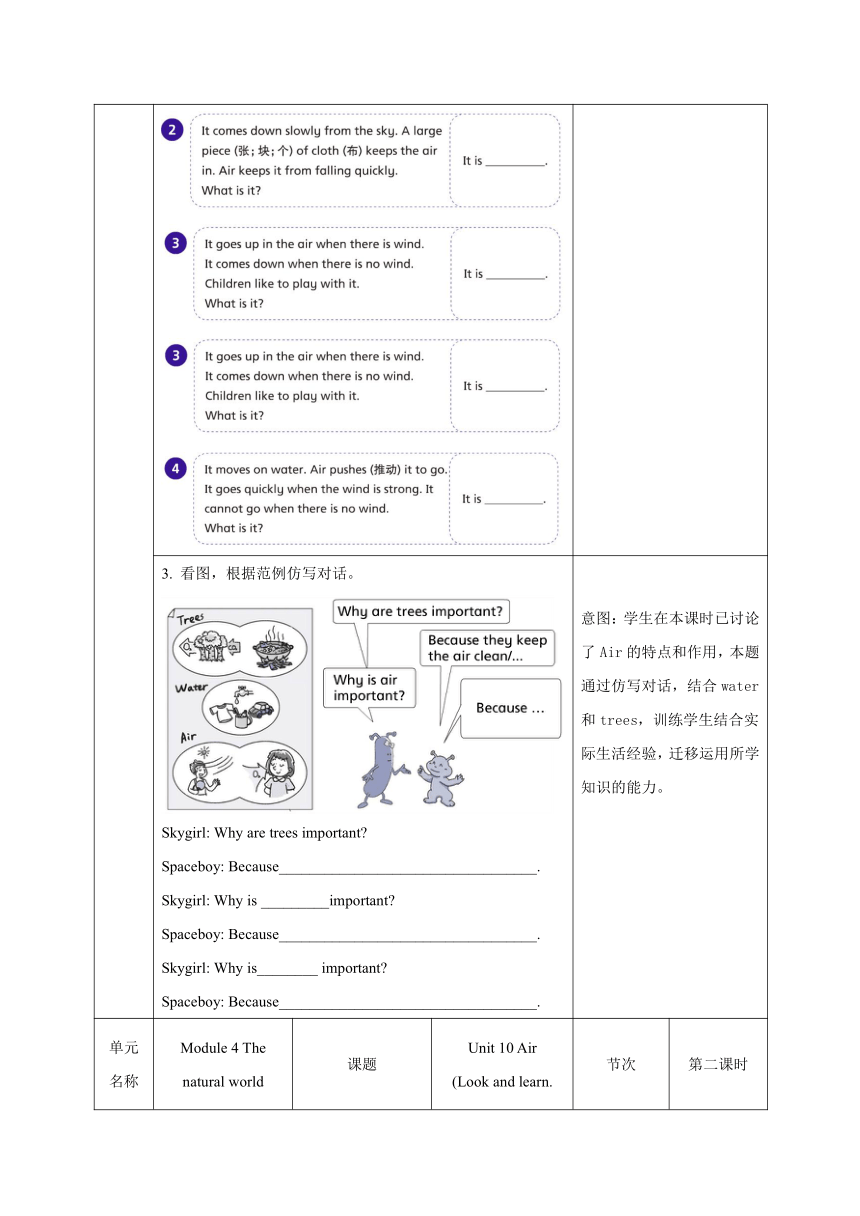Module 4 Unit 10 Air 作业设计 4课时 (含设计意图,无答案)
文档属性
| 名称 | Module 4 Unit 10 Air 作业设计 4课时 (含设计意图,无答案) |  | |
| 格式 | docx | ||
| 文件大小 | 2.4MB | ||
| 资源类型 | 教案 | ||
| 版本资源 | 牛津深圳版 | ||
| 科目 | 英语 | ||
| 更新时间 | 2021-12-06 10:58:15 | ||
图片预览





文档简介
单元名称 Module 4 The natural world Unit 10 Air 课题 Unit 10 Air (Listen and say. Make and say.) 节次 第一课时
作业类型 作业内容 设计意图
基础性作业 (必做) 根据首字母提示,看图写单词。 (1) A_____ keeps the plane high in the sky. (2) The trees are e____________. (3) Air k_____ us a_______. It’s important to all people. (4) There are many animals and p________. 意图:学上在本课时已学过这些新词,通过生动的看图写词,训练学生单元核心词汇的形义识记,基础词汇学习。
2.连词成句,注意标点符号和大小写。 (1)it, shape, has, or, no, colour. _________________________________________________ (2)important, animals, plants, it, and, is, also, to. _________________________________________________ (3)alive, need, we it, to all, keep, us. _________________________________________________ (4)in, sky, it, them, high, keeps, the. _________________________________________________ 意图: 在学生学习本课时文本的基础上,通过连词成句,复习基础核心句型It keeps….训练学生的句子书写能力。
3.读一读,选择恰当的单词填空。 意图:学生在本课时已通过句型We all need it to keep us alive. It has no colour or taste. 学习了介词to和or的意义和用法,本题结合以前学过的其它介词about, from, in, of,训练学生的介词辨析与运用能力。
拓展性作业(选做) 1. 读一读,学一学含air的短语,然后选择恰当的短语填空。 意图:在学生学完课文 Listen and say的基础上,拓展关于air的日常短语表达,通过阅读理解填空,在训练阅读能力的同时,拓宽学生在相关主题的词汇和知识面。
读一读,选一选,并把图片对应的序号填写在横线上。 意图:学生已经在Make and say 栏目已经学习如何制作降落伞。本题拓展更多借助空气流动的物品,让学生阅读配对,结合自然科学知识,激发学生阅读兴趣,锻炼科普文阅读能力。
3. 看图,根据范例仿写对话。 Skygirl: Why are trees important Spaceboy: Because__________________________________. Skygirl: Why is _________important Spaceboy: Because__________________________________. Skygirl: Why is________ important Spaceboy: Because__________________________________. 意图:学生在本课时已讨论了Air的特点和作用,本题通过仿写对话,结合water和trees,训练学生结合实际生活经验,迁移运用所学知识的能力。
单元名称 Module 4 The natural world Unit 10 Air 课题 Unit 10 Air (Look and learn. Say and act.) 节次 第二课时
作业类型 作业内容 设计意图
基础性作业 (必做) 1.看图写词。 (1)_______________ (2)_______________ (3)_______________ (4)_______________ (5)The air is so_______ in the park. We should ______ more______. 意图:学生在本课时已经学习这些核心词汇,本题利用图文配对,训练学生单元核心词汇的形义识记,基础词汇学习。
2.读一读,用所给单词的适当形式填空。 意图:学生在本课时继续基础核心句型It keeps …,并学习新句型It makes…本题结合课文内容,训练学生在具体情景中运用这两个核心句型的能力。
3. 选择恰当的单词填空,一空一词。 smell underground trees fresh important clean riding taste smoke 意图:学生在Say and act课文中已学习讨论空气污染的原因,以及人们应该采取的应对措施。本题结合第一课时对空气的介绍和描述,训练学生知识整合与综合运用能力。
拓展性作业(选做) 1.根据课文内容填空。 Kitty and Ben are walking on the (1)________. Suddenly, Kitty’s eyes are (2)_____. It’s the (3)______ from the cars and buses. They also see the black smoke from the (4)______. It (5)_____ the air dirty. So, they decide to go to the park. The air in the park is so (6)_ _____ , because there are a lot of trees. Those trees (7)______ the air (8)_____. So, Kitty and Ben both think people should (9)_____ more trees to keep their (10)_______ clean. 意图:在学生学习Say and act课文的基础上,基础课文,训练学生对课文的理解及核心词汇的运用,提高学生课文复述能力,内化语言知识。
读一读,判断下面的句子是否正确,正确的选F,错误的选T。 By the 1950s, the air pollution got so bad in London. In 1952, there was a smog(雾霾) that lasted for 4 days. And around 4,000 people died because the air was so dirty. It was called The Great Smog of London. People thought the dirty air came from the factories. But a lot of it came from the coal(煤炭). Because people used it in their houses to keep warm in winter. Then, the government limited people in using coal. A few years later, the air became much cleaner. 意图:在学生学习本课时文本的基础上,本题拓展阅读文本“伦敦烟雾事件”,并通过理解判断,培养学生略读、寻读等获取关键信息的能力,同时扩大学生相关主题词汇量及知识面。
观察表格,和你的小伙伴讨论下面这些城市在2013年的空气质量,分析哪些因素影响空气质量,并提出你的建议。(注:AQI指数越高表明空气质量越差)。 _____________________________________________________ _____________________________________________________ _____________________________________________________ _____________________________________________________ _____________________________________________________ _____________________________________________________ _____________________________________________________ 意图:在学生内化课文的基础上,通过讨论和实况调查,训练学生解决实际生活问题的能力;通过提示写作,培养学生调研写作能力。
单元名称 Module 4 The natural world Unit 10 Air 课题 Unit 10 Air (Ask and answer, Learn the sounds, Think and write) 节次 第三课时
作业类型 作业内容 设计意图
基础性 作业 (必做) 读一读,圈出划线部分发音与其它两个不同的单词。 (1)chair cheap sheep (2)giraffe job each (3)usually share pleasure (1)orange choose jam 意图:学生在课上学习ch/g/j/sh/s的发音后,通过辨别相近发音,训练学生本单语音知识在具体单词中的识别,提高学生语音意识,突破发音难点。
选择填空。 意图:在学生课上基础本单元核心词句后,进行针对性练习:It keeps…/We should…/…make…。训练学生对本单元核心词汇、短语在具体语境中的综合运用,基础语言知识并提高学生的相近词辨析能力。
读一读,用所给单词的适当形式填空。 意图:学生在第1-2课时已掌握本单元的核心词汇,本题通过用所给单词的适当形式填空,训练学生正确运用单元核心词汇的能力。
拓展性 作业 (选做) 看图,完成对话。 意图:学生在本课时通过Ask and answer口头讨论过空气污染的原因和措施,本题通过看图编写对话,结合第一课时对空气作用的复习,训练学生运用本单元核心句型书写对话的能力。
阅读对话,完成填空。 Kitty and Alice are doing a survey about the air in the streets. City A Kitty: Is the air clean in your city Man: I think the air in my city is clean. There are not many cars and factories, and we often go around by bike. People here plant many trees. We all need trees to keep the air clean and fresh. City B Alice: Hello! Is the air clean in your city Tourist: Hi, I’m a tourist here. There’re many cars and buses on the road. And people smoke a lot. It makes the air dirty. Alice: What should we do to keep the air clean Tourist: Clean air is important to people. We should use less cars and plant more trees. 意图:学生在前2-3课时已学习“保护空气”的对话,讨论过空气污染的现状、原因和对策;本题通过对话阅读理解,拓展学生相关主题词汇量及知识面,并通过总结填空培养学生通过略读、寻读来获取关键信息的能力。
3. 请你根据思维导图和里面的编号提示,完成短文。 意图:学生在本课时Think and write 部分已经简单写过保护空气的倡议书,包括:空气的重要性、空气污染的原因以及我们应该采取的行动。本题通过思维导图进一步拓展这三个方面的细节,训练学生支架写作能力,锻炼写作逻辑思维。
单元名称 Module 4 The natural world Unit 10 Air 课题 Unit 10 Air(Review) 节次 第四课时
作业类型 作业内容 设计意图
基础性 作业 (必做) 1.请参考范例,另外写出2个含以下字母,且发音与范例划线部分相同的单词。 ch: chair ________ __________ g: danger ________ __________ j: jump ________ __________ sh: brush ________ __________ s: television ________ __________ 意图:学生在第三课时已学习本单元的语音栏目,且做了辨析相近发音的练习,本题进一步提高难度,训练学生根据语音自主联想单词的能力。
2. 看图,根据首字母提示,完成句子。 意图:学生在前三个课时已经学习和操练了本单元核心词汇,本题通过首字母单词填空,进一步复习基础学生在具体语境中书写核心词汇的能力。
3.读一读,选一选,填一填。 意图:在四个课时的学习后,本题通过语境及单词填空,训练学生本单元核心词汇的理解记忆,提高学生在具体语境中辨析和应用本单元核心词汇的能力。
拓展性 作业 (选做) 阅读下列句子,给图片排序。 (1) Can you see the smoke from the factory —Yes. It’s black and white. It makes the air dirty. (2) Why do we pant trees, mum and dad —Because trees make the air clean and fresh. (3) Please don’t smoke. It’s not healthy. (4) Air is important. It keeps us alive. It’s also important to planes and birds. (5) The wind keeps the kites high in the sky. 意图:学生经过四个课时的学习,已经能熟练阅读有关空气的句子和对话。本题让学生读句子给图片排序,在趣味情景中训练单元核心句型的理解运用。
阅读短文,选出正确的答案。 The Garden City is in the west of China. Many years ago, the Garden City was very beautiful. The air there was clean and fresh. But now the air is very dirty. The smoke from cars and factories made the air dirty. Air is important to all of us. It keeps us alive. It’s our duty(责任)to keep the air clean and fresh. We should ride our bikes more often. We shouldn’t build any factories in the city center. And we should plant more trees. 意图:学生在四个课时学习后,已经能熟练阅读本单元主题相关内容,本题通过拓展阅读,训练学生略读、寻读等获取关键信息的能力,同时扩大学生相关主题词汇量及知识面。
根据下列步骤,制作一张保护空气的海报。第一步:找一找空气污染的照片贴在方框里。 第二步:在网上搜索保持空气洁净的办法,根据提示句型写一写。第三步:参考示范画一些保护空气的标志。 意图:四个课时结束后,程度较好的学生已经能书写更多关于保护空气话题的内容,本题联系学生生活实际,以制作海报的形式搭建脚手架,落实笔头训练,同时给学生一定的自主创作空间,提高学生的综合语言运用能力。
作业类型 作业内容 设计意图
基础性作业 (必做) 根据首字母提示,看图写单词。 (1) A_____ keeps the plane high in the sky. (2) The trees are e____________. (3) Air k_____ us a_______. It’s important to all people. (4) There are many animals and p________. 意图:学上在本课时已学过这些新词,通过生动的看图写词,训练学生单元核心词汇的形义识记,基础词汇学习。
2.连词成句,注意标点符号和大小写。 (1)it, shape, has, or, no, colour. _________________________________________________ (2)important, animals, plants, it, and, is, also, to. _________________________________________________ (3)alive, need, we it, to all, keep, us. _________________________________________________ (4)in, sky, it, them, high, keeps, the. _________________________________________________ 意图: 在学生学习本课时文本的基础上,通过连词成句,复习基础核心句型It keeps….训练学生的句子书写能力。
3.读一读,选择恰当的单词填空。 意图:学生在本课时已通过句型We all need it to keep us alive. It has no colour or taste. 学习了介词to和or的意义和用法,本题结合以前学过的其它介词about, from, in, of,训练学生的介词辨析与运用能力。
拓展性作业(选做) 1. 读一读,学一学含air的短语,然后选择恰当的短语填空。 意图:在学生学完课文 Listen and say的基础上,拓展关于air的日常短语表达,通过阅读理解填空,在训练阅读能力的同时,拓宽学生在相关主题的词汇和知识面。
读一读,选一选,并把图片对应的序号填写在横线上。 意图:学生已经在Make and say 栏目已经学习如何制作降落伞。本题拓展更多借助空气流动的物品,让学生阅读配对,结合自然科学知识,激发学生阅读兴趣,锻炼科普文阅读能力。
3. 看图,根据范例仿写对话。 Skygirl: Why are trees important Spaceboy: Because__________________________________. Skygirl: Why is _________important Spaceboy: Because__________________________________. Skygirl: Why is________ important Spaceboy: Because__________________________________. 意图:学生在本课时已讨论了Air的特点和作用,本题通过仿写对话,结合water和trees,训练学生结合实际生活经验,迁移运用所学知识的能力。
单元名称 Module 4 The natural world Unit 10 Air 课题 Unit 10 Air (Look and learn. Say and act.) 节次 第二课时
作业类型 作业内容 设计意图
基础性作业 (必做) 1.看图写词。 (1)_______________ (2)_______________ (3)_______________ (4)_______________ (5)The air is so_______ in the park. We should ______ more______. 意图:学生在本课时已经学习这些核心词汇,本题利用图文配对,训练学生单元核心词汇的形义识记,基础词汇学习。
2.读一读,用所给单词的适当形式填空。 意图:学生在本课时继续基础核心句型It keeps …,并学习新句型It makes…本题结合课文内容,训练学生在具体情景中运用这两个核心句型的能力。
3. 选择恰当的单词填空,一空一词。 smell underground trees fresh important clean riding taste smoke 意图:学生在Say and act课文中已学习讨论空气污染的原因,以及人们应该采取的应对措施。本题结合第一课时对空气的介绍和描述,训练学生知识整合与综合运用能力。
拓展性作业(选做) 1.根据课文内容填空。 Kitty and Ben are walking on the (1)________. Suddenly, Kitty’s eyes are (2)_____. It’s the (3)______ from the cars and buses. They also see the black smoke from the (4)______. It (5)_____ the air dirty. So, they decide to go to the park. The air in the park is so (6)_ _____ , because there are a lot of trees. Those trees (7)______ the air (8)_____. So, Kitty and Ben both think people should (9)_____ more trees to keep their (10)_______ clean. 意图:在学生学习Say and act课文的基础上,基础课文,训练学生对课文的理解及核心词汇的运用,提高学生课文复述能力,内化语言知识。
读一读,判断下面的句子是否正确,正确的选F,错误的选T。 By the 1950s, the air pollution got so bad in London. In 1952, there was a smog(雾霾) that lasted for 4 days. And around 4,000 people died because the air was so dirty. It was called The Great Smog of London. People thought the dirty air came from the factories. But a lot of it came from the coal(煤炭). Because people used it in their houses to keep warm in winter. Then, the government limited people in using coal. A few years later, the air became much cleaner. 意图:在学生学习本课时文本的基础上,本题拓展阅读文本“伦敦烟雾事件”,并通过理解判断,培养学生略读、寻读等获取关键信息的能力,同时扩大学生相关主题词汇量及知识面。
观察表格,和你的小伙伴讨论下面这些城市在2013年的空气质量,分析哪些因素影响空气质量,并提出你的建议。(注:AQI指数越高表明空气质量越差)。 _____________________________________________________ _____________________________________________________ _____________________________________________________ _____________________________________________________ _____________________________________________________ _____________________________________________________ _____________________________________________________ 意图:在学生内化课文的基础上,通过讨论和实况调查,训练学生解决实际生活问题的能力;通过提示写作,培养学生调研写作能力。
单元名称 Module 4 The natural world Unit 10 Air 课题 Unit 10 Air (Ask and answer, Learn the sounds, Think and write) 节次 第三课时
作业类型 作业内容 设计意图
基础性 作业 (必做) 读一读,圈出划线部分发音与其它两个不同的单词。 (1)chair cheap sheep (2)giraffe job each (3)usually share pleasure (1)orange choose jam 意图:学生在课上学习ch/g/j/sh/s的发音后,通过辨别相近发音,训练学生本单语音知识在具体单词中的识别,提高学生语音意识,突破发音难点。
选择填空。 意图:在学生课上基础本单元核心词句后,进行针对性练习:It keeps…/We should…/…make…。训练学生对本单元核心词汇、短语在具体语境中的综合运用,基础语言知识并提高学生的相近词辨析能力。
读一读,用所给单词的适当形式填空。 意图:学生在第1-2课时已掌握本单元的核心词汇,本题通过用所给单词的适当形式填空,训练学生正确运用单元核心词汇的能力。
拓展性 作业 (选做) 看图,完成对话。 意图:学生在本课时通过Ask and answer口头讨论过空气污染的原因和措施,本题通过看图编写对话,结合第一课时对空气作用的复习,训练学生运用本单元核心句型书写对话的能力。
阅读对话,完成填空。 Kitty and Alice are doing a survey about the air in the streets. City A Kitty: Is the air clean in your city Man: I think the air in my city is clean. There are not many cars and factories, and we often go around by bike. People here plant many trees. We all need trees to keep the air clean and fresh. City B Alice: Hello! Is the air clean in your city Tourist: Hi, I’m a tourist here. There’re many cars and buses on the road. And people smoke a lot. It makes the air dirty. Alice: What should we do to keep the air clean Tourist: Clean air is important to people. We should use less cars and plant more trees. 意图:学生在前2-3课时已学习“保护空气”的对话,讨论过空气污染的现状、原因和对策;本题通过对话阅读理解,拓展学生相关主题词汇量及知识面,并通过总结填空培养学生通过略读、寻读来获取关键信息的能力。
3. 请你根据思维导图和里面的编号提示,完成短文。 意图:学生在本课时Think and write 部分已经简单写过保护空气的倡议书,包括:空气的重要性、空气污染的原因以及我们应该采取的行动。本题通过思维导图进一步拓展这三个方面的细节,训练学生支架写作能力,锻炼写作逻辑思维。
单元名称 Module 4 The natural world Unit 10 Air 课题 Unit 10 Air(Review) 节次 第四课时
作业类型 作业内容 设计意图
基础性 作业 (必做) 1.请参考范例,另外写出2个含以下字母,且发音与范例划线部分相同的单词。 ch: chair ________ __________ g: danger ________ __________ j: jump ________ __________ sh: brush ________ __________ s: television ________ __________ 意图:学生在第三课时已学习本单元的语音栏目,且做了辨析相近发音的练习,本题进一步提高难度,训练学生根据语音自主联想单词的能力。
2. 看图,根据首字母提示,完成句子。 意图:学生在前三个课时已经学习和操练了本单元核心词汇,本题通过首字母单词填空,进一步复习基础学生在具体语境中书写核心词汇的能力。
3.读一读,选一选,填一填。 意图:在四个课时的学习后,本题通过语境及单词填空,训练学生本单元核心词汇的理解记忆,提高学生在具体语境中辨析和应用本单元核心词汇的能力。
拓展性 作业 (选做) 阅读下列句子,给图片排序。 (1) Can you see the smoke from the factory —Yes. It’s black and white. It makes the air dirty. (2) Why do we pant trees, mum and dad —Because trees make the air clean and fresh. (3) Please don’t smoke. It’s not healthy. (4) Air is important. It keeps us alive. It’s also important to planes and birds. (5) The wind keeps the kites high in the sky. 意图:学生经过四个课时的学习,已经能熟练阅读有关空气的句子和对话。本题让学生读句子给图片排序,在趣味情景中训练单元核心句型的理解运用。
阅读短文,选出正确的答案。 The Garden City is in the west of China. Many years ago, the Garden City was very beautiful. The air there was clean and fresh. But now the air is very dirty. The smoke from cars and factories made the air dirty. Air is important to all of us. It keeps us alive. It’s our duty(责任)to keep the air clean and fresh. We should ride our bikes more often. We shouldn’t build any factories in the city center. And we should plant more trees. 意图:学生在四个课时学习后,已经能熟练阅读本单元主题相关内容,本题通过拓展阅读,训练学生略读、寻读等获取关键信息的能力,同时扩大学生相关主题词汇量及知识面。
根据下列步骤,制作一张保护空气的海报。第一步:找一找空气污染的照片贴在方框里。 第二步:在网上搜索保持空气洁净的办法,根据提示句型写一写。第三步:参考示范画一些保护空气的标志。 意图:四个课时结束后,程度较好的学生已经能书写更多关于保护空气话题的内容,本题联系学生生活实际,以制作海报的形式搭建脚手架,落实笔头训练,同时给学生一定的自主创作空间,提高学生的综合语言运用能力。
同课章节目录
- Module 1 Getting to know each other
- Unit 1 Growing up
- Unit 2 My summer holiday
- Unit 3 Healthy or unhealthy?
- Revision 1
- Project 1
- Module 2 Relationships
- Unit 4 Our neighbours
- Unit 5 Animals in dange
- Unit 6 E-friends
- Revision 2
- Project 2
- Module 3 Out and about
- Unit 7 Seeing a film
- Unit 8 Visiting museums
- Unit 9 Great cities of the world
- Revision 3
- Project 3
- Module 4 The natural world
- Unit 10 Ai
- Unit 11 Trees
- Unit 12 The Earth
- Revision 4
- Project 4
